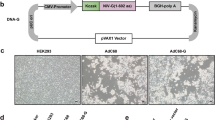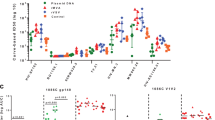Abstract
We measured the ability of nine DNA vaccine plasmids encoding candidate malaria vaccine antigens to induce antibodies and interferon-γ responses when delivered alone or in a mixture containing all nine plasmids. We further examined the possible immunosuppressive effect of individual plasmids, by assessing a series of mixtures in which each of the nine vaccine plasmids was replaced with a control plasmid. Given alone, each of the vaccine plasmids induced significant antibody titers and, in the four cases for which appropriate assays were available, IFN-γ responses. Significant suppression or complete abrogation of responses were seen when the plasmids were pooled in a nine-plasmid cocktail and injected in a single site. Removal of single genes from the mixture frequently reduced the observed suppression. Boosting with recombinant poxvirus increased the antibody response in animals primed with either a single gene or the mixture, but, even after boosting, responses were higher in animals primed with single plasmids than in those primed with the nine-plasmid mixture. Boosting did not overcome the suppressive effect of mixing for IFN-γ responses. Interactions between components in a multiplasmid DNA vaccine may limit the ability to use plasmid pools alone to induce responses against multiple targets simultaneously.
This is a preview of subscription content, access via your institution
Access options
Subscribe to this journal
Receive 12 print issues and online access
$259.00 per year
only $21.58 per issue
Buy this article
- Purchase on Springer Link
- Instant access to full article PDF
Prices may be subject to local taxes which are calculated during checkout




Similar content being viewed by others
References
Fattom A et al. Epitopic overload at the site of injection may result in suppression of the immune response to combined capsular polysaccharide conjugate vaccines. Vaccine 1999; 17: 126–133.
Hunt JD et al. Antigenic competition in a multivalent foot rot vaccine. Vaccine 1994; 12: 457–464.
Doolan DL et al. Circumventing genetic restriction of protection against malaria with multi-gene DNA immunization: CD8+ T cell, interferon-gamma, and nitric oxide dependent immunity. J Exp Med 1996; 183: 1739–1746.
Morris S et al. The immunogenicity of single and combination DNA vaccines against tuberculosis. Vaccine 2000; 18: 2155–2163.
Grifantini R et al. Multi-plasmid DNA vaccination avoids antigenic competition and enhances immunogenicity of a poorly immunogenic plasmid. Eur J Immunol 1998; 28: 1225–1232.
Narum DL et al. Codon optimization of gene fragments encoding Plasmodium falciparum merzoite proteins enhances DNA vaccine protein expression and immunogenicity in mice. Infect Immun 2001; 69: 7250–7253.
Luke CJ et al. An OspA-based DNA vaccine protects mice against infection with Borrelia burgdorferi. J Infect Dis 1997; 175: 91–97.
Stoute JA et al. Long-term efficacy and immune responses following immunization with the RTS,S malaria vaccine. J Infect Dis 1998; 178: 1139–1144.
Tine JA et al. NYVAC-Pf7: a poxvirus-vectored, multiantigen, multistage vaccine candidate for Plasmodium falciparum malaria. Infect Immun 1996; 64: 3833–3844.
Kaslow DC, Hui G, Kumar S . Expression and antigenicity of Plasmodium falciparum major merozoite surface protein (MSP1(19)) variants secreted from Saccharomyces cerevisiae. Mol Biochem Parasitol 1994; 63: 283–289.
Liang H et al. A recombinant baculovirus-expressed Plasmodium falciparum receptor-binding domain of erythrocyte binding protein EBA-175 biologically mimics native protein. Infect Immun 2000; 68: 3564–3568.
Charoenvit Y et al. CD4(+) T-cell- and gamma interferon-dependent protection against murine malaria by immunization with linear synthetic peptides from a Plasmodium yoelii 17-kilodalton hepatocyte erythrocyte protein. Infect Immun 1999; 67: 5604–5614.
Szarfman A et al. Mature liver stages of cloned Plasmodium falciparum share epitopes with proteins from sporozoites and asexual blood stages. Parasite Immunol 1988; 10: 339–351.
Charoenvit Y et al. Characterization of Plasmodium yoelii monoclonal antibodies directed against stage-specific sporozoite antigens. Infect Immun 1987; 55: 604–608.
Sedegah M et al. Improving protective immunity induced by DNA-based immunization: priming with antigen and GM-CSF-encoding plasmid DNA and boosting with antigen-expressing recombinant poxvirus. J Immunol 2000; 164: 5905–5912.
Doolan DL, Hoffman SL . Multi-gene vaccination against malaria: a multistage, multi-immune response approach. Parasitol Today 1997; 13: 171–178.
Wang R et al. Simultaneous induction of multiple antigen-specific cytotoxic T lymphocytes in nonhuman primates by immunization with a mixture of four Plasmodium falciparum DNA plasmids. Infect Immun 1998; 66: 4193–4202.
Jones TR et al. Absence of antigenic competition in Aotus monkeys immunized with Plasmodium falciparum DNA vaccines delivered as a mixture. Vaccine 2-22-2002; 20: 1675–1680.
Schneider J et al. Enhanced immunogenicity for CD8+ T cell induction and complete protective efficacy of malaria DNA vaccination by boosting with modified vaccinia virus Ankara. Nat Med 1998; 4: 397–402.
Sedegah M et al. Boosting with recombinant vaccinia increases immunogenicity and protective efficacy of a malaria DNA vaccine. Proc Natl Acad Sci USA 1998; 95: 7648–7653.
Acknowledgements
This work was supported by the Naval Medical Research Center (Military Infectious Diseases Research Program) work units 61102A.S13.F.A0009 and 62787A.870.F.A0010, and by the Office of Naval Research Grant N00014-89-J-1856 to The University of Maryland at Baltimore (MS). The assertions herein are the private ones of the authors and are not to be construed as official or as reflecting the views of the US Navy or the Naval service at large. In conducting the research described in this report, all aspects involving animal use were conducted in an AAALAC accredited facility, and in accordance with the Animal Welfare Act implementing the instructions (9 CFR, Subchapter A, Parts 1–3), Department of Defense regulations, and recognized standards relating to the care and use of laboratory animals. We thank David Lanar (Walter Reed Army Institute for Research) for recombinant PfCSP, PfSSP2, and PfLSA1; Jennifer Meeks and Autumn Ramirez (Vical, Inc.) for assistance in preparing plasmid mixtures; R Ridley (Hoffman-La-Roche) for anti-Exp1 mAb N1, Tony Holder (NIMR, Mill Hill) for anti-MSP1 mAb 5.2, and Alan Thomas for anti-AMA-1 mAb 4G2; and HM1 Robert Arcilla, HM1 Arnel Belmonte, HM2 Thomas Smalls, and Patricia de la Vega for excellent technical assistance and providing P. falciparum parasites.
Author information
Authors and Affiliations
Rights and permissions
About this article
Cite this article
Sedegah, M., Charoenvit, Y., Minh, L. et al. Reduced immunogenicity of DNA vaccine plasmids in mixtures. Gene Ther 11, 448–456 (2004). https://doi.org/10.1038/sj.gt.3302139
Received:
Accepted:
Published:
Issue Date:
DOI: https://doi.org/10.1038/sj.gt.3302139
Keywords
This article is cited by
-
Novel Plasmodium antigens identified via genome-based antibody screen induce protection associated with polyfunctional T cell responses
Scientific Reports (2017)
-
Enhancing protective immunity to malaria with a highly immunogenic virus-like particle vaccine
Scientific Reports (2017)
-
Immunogenicity of a chimeric Plasmodium falciparum merozoite surface protein vaccine in Aotus monkeys
Malaria Journal (2016)
-
Identification of two new protective pre-erythrocytic malaria vaccine antigen candidates
Malaria Journal (2011)
-
A New Multi-clade DNA Prime/Recombinant MVA Boost Vaccine Induces Broad and High Levels of HIV-1-specific CD8+ T-cell and Humoral Responses in Mice
Molecular Therapy (2007)



